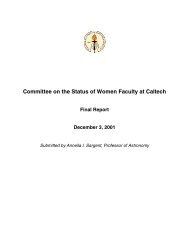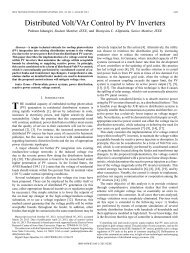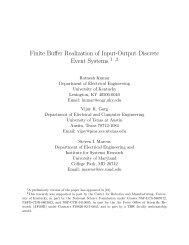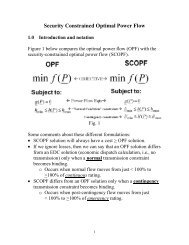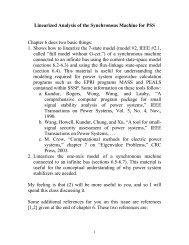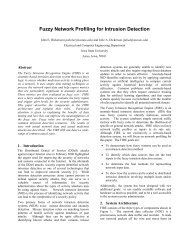assigned to each of the subsequent nodes of p ′ , we get:|X 1 | ≤ 2 i · (|p ′ | − 1) + 2 i+1 = 2 i · |p| ≤ 2 i · (1 + log W ). (2)With a similar analysis (the details are omitted due to space constraints) incan be shown that:|X 2 ∪ X 3 | ≤ 2 i · (1 + log W ). (3)Combining Equations 1, 2, and 3 we can bound s t − e i t :−2 i · (1 + log W ) ≤ −|X 1 | ≤ s t − e i t ≤ |X 2 ∪ X 3 | ≤ 2 i · (1 + log W ).There<strong>for</strong>e, |s t − e i t | ≤ 2i · (1 + log W ). In case S i ′ = ∅, ei t = s t − |X 3 | = 0, and thesame bound follows immediately.⊓⊔Lemma 2. When asked <strong>for</strong> an estimate of the number of timestamps in [c−w, c](1)There exists a level i ∈ [0, M] such that T i < c − w, and(2)<strong>Algorithm</strong> 3 returns e l c−w where l ∈ [0, M] is the smallest level such thatT l < c − w.The proof of Lemma 2 is omitted due to space constraints, and can be foundin the full version [3]. Let l denote the level used by <strong>Algorithm</strong> 3 to answer aquery <strong>for</strong> the number of timestamps in [c − w, c]. From Lemma 2 we know lalways exists.Lemma 3. If l > 0, then s c−w ≥(1+log W )·2lɛ.Proof. If l > 0, it must be true that T l−1 ≥ c − w, since otherwise level l − 1would have been chosen. Let t = T l−1 + 1. Then, t > c − w, and thus s c−w ≥ s t .From Lemma 1, we know s t ≥ e l−1t − (1 + log W ) · 2 l−1 . Thus we have:s c−w ≥ e l−1t − (1 + log W ) · 2 l−1 (4)We know that <strong>for</strong> each bucket b ∈ S l−1 , l(b) ≥ t. Further we know that eachbucket in S l−1 has a weight of at least 2 l−1 (only the initial bucket in S l−1may have a smaller weight, but this bucket must have split, since otherwise T l−1would still be −1). Since there are α buckets in S l−1 , we have:e l−1t ≥ α2 l−1 ≥ (1 + log W ) · 2 + ɛ · 2 l−1ɛ(5)The lemma follows from Equations 4 and 5.⊓⊔Theorem 1. The answer returned by <strong>Algorithm</strong> 3 is within an ɛ relative errorof s c−w .Proof. Let X denote the value returned by <strong>Algorithm</strong> 3. If l = 0, it can beverified that <strong>Algorithm</strong> 3 returns exactly s c−w (proof omitted due to space constraints).If l > 0, from Lemmas 1 and 2, we have |X − s c−w | ≤ (1 + log W ) · 2 l .Using Lemma 3, we get |X − s c−w | ≤ ɛ · s c−w as needed.⊓⊔
Theorem 2. The worst case space required by the data structure <strong>for</strong> basic countingis O((log W · log B) · (log W + log B)/ɛ) where B is an upper bound on thevalue of the basic count, W is an upper bound on the window size w, and ɛ isthe desired upper bound on the relative error. The worst case time taken by <strong>Algorithm</strong>2 to process a new element is O(log W · log B), and the worst case timetaken by <strong>Algorithm</strong> 3 to answer a query <strong>for</strong> basic counting is O(log B + log Wɛ).The proof is omitted due to space constraints, and can be found in the fullversion [3].3 Sum of Positive IntegersWe now consider the maintenance of a sketch <strong>for</strong> the sum, which is a generalizationof basic counting. The stream is a sequence of tuples R = d 1 = (v 1 , t 1 ), d 2 =(v 2 , t 2 ), . . . , d n = (v n , t n ) where the v i s are positive integers, corresponding tothe observations, and t i s are the timestamps of the observations. Let c denotethe current time. The goal is to maintain a sketch of R which will provide ananswer <strong>for</strong> the following query. For a user provided w ≤ W that is given at thetime of the query, return the sum of the values of stream elements that are withinthe current timestamp window [c − w, c]. Clearly, basic counting is a special casewhere all v i s are equal to 1.An arriving element (v, t), is treated as v different elements each of value 1and timestamp t, and these v elements are inserted into the data structure <strong>for</strong>basic counting. Finally, when asked <strong>for</strong> an estimate <strong>for</strong> the sum, the algorithm<strong>for</strong> handling a query in basic counting (<strong>Algorithm</strong> 3) is used. The correctnessof this algorithm <strong>for</strong> the sum follows from the correctness of the basic countingalgorithm (Theorem 1). The space complexity of this algorithm is the same asthe space complexity of basic counting, the only difference being that the numberof levels in the algorithm <strong>for</strong> the sum is M = ⌈log B⌉, where B is an upper boundon the value of the sum within the sliding window (in the case of basic counting,B was an upper bound on the number of elements within the window).If naively executed, the time complexity of the above procedure <strong>for</strong> processingan element (v, t) could be large, since v could be large. The time complexityof processing an element can be reduced by directly computing the final stateof the basic counting data structure after inserting all the v elements. The intuitionbehind the faster processing is as follows. The element (v, t) is insertedinto each of the M + 1 levels. In each level i, i = 0, . . . , M, the v elements areinserted into S i in batches of unit elements (1, t) taken from (v, t). A batch containsenough elements to cause the current bucket containing timestamp t tosplit. The next batch contains enough elements from v to cause the new bucketcontaining timestamp t to split, too, and so on. The process repeats until abucket containing timestamp t cannot split further. This occurs when at mostO(max(v/2 i , log W )) batches are processed (and a similar number of respectivenew buckets is created), since at most O(2 i ) elements from v are processed ateach iteration in a batch, and a bucket can be recursively split at most log W




